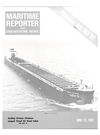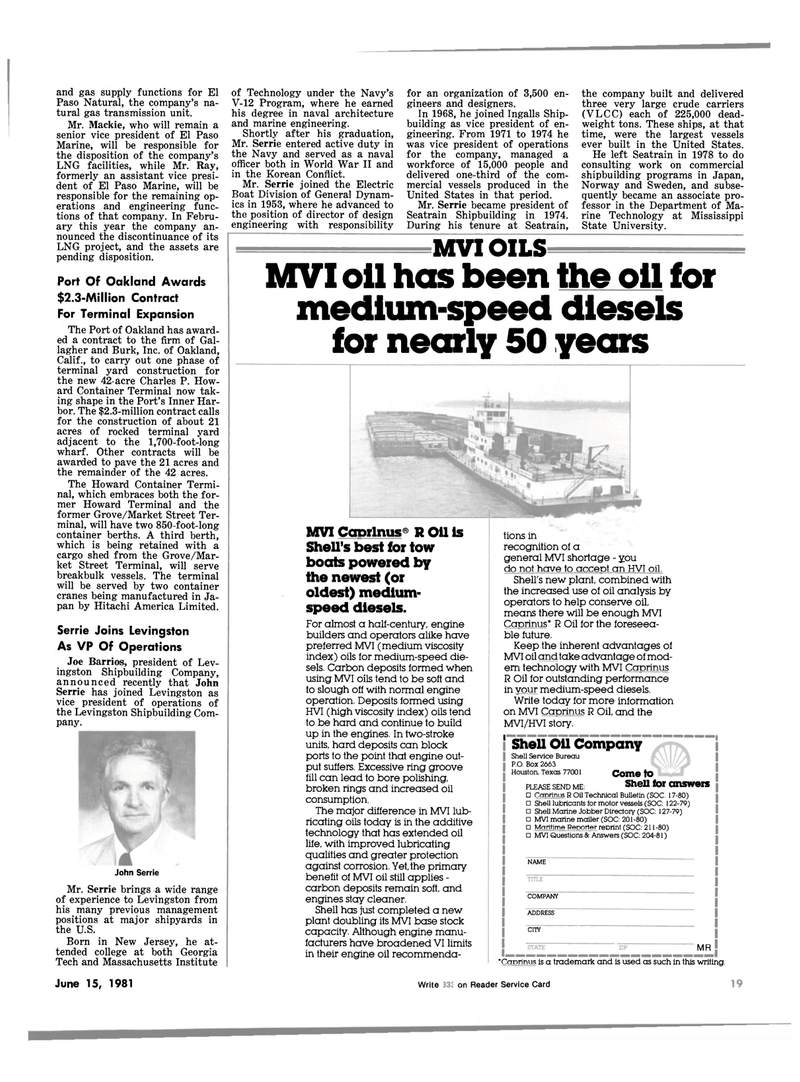
Page 17: of Maritime Reporter Magazine (June 15, 1981)
Read this page in Pdf, Flash or Html5 edition of June 15, 1981 Maritime Reporter Magazine
and gas supply functions for El
Paso Natural, the company's na- tural gas transmission unit.
Mr. Mackie, who will remain a senior vice president of El Paso
Marine, will be responsible for the disposition of the company's
LNG facilities, while Mr. Ray, formerly an assistant vice presi- dent of El Paso Marine, will be responsible for the remaining op- erations and engineering func- tions of that company. In Febru- ary this year the company an- nounced the discontinuance of its
LNG project, and the assets are pending disposition.
Port Of Oakland Awards $2.3-Million Contract
For Terminal Expansion
The Port of Oakland has award- ed a contract to the firm of Gal- lagher and Burk, Inc. of Oakland,
Calif., to carry out one phase of terminal yard construction for the new 42-acre Charles P. How- ard Container Terminal now tak- ing shape in the Port's Inner Har- bor. The $2.3-million contract calls for the construction of about 21 acres of rocked terminal yard adjacent to the 1,700-foot-long wharf. Other contracts will be awarded to pave the 21 acres and the remainder of the 42 acres.
The Howard Container Termi- nal, which embraces both the for- mer Howard Terminal and the former Grove/Market Street Ter- minal, will have two 850-foot-long container berths. A third berth, which is being retained with a cargo shed from the Grove/Mar- ket Street Terminal, will serve breakbulk vessels. The terminal will be served by two container cranes being manufactured in Ja- pan by Hitachi America Limited.
Serrie Joins Levingston
As VP Of Operations
Joe Barrios, president of Lev- ingston Shipbuilding Company, announced recently that John
Serrie has joined Levingston as vice president of operations of the Levingston Shipbuilding Com- pany.
John Serrie
Mr. Serrie brings a wide range of experience to Levingston from his many previous management positions at major shipyards in the U.S.
Born in New Jersey, he at- tended college at both Georgia
Tech and Massachusetts Institute of Technology under the Navy's
V-12 Program, where he earned his degree in naval architecture and marine engineering.
Shortly after his graduation,
Mr. Serrie entered active duty in the Navy and served as a naval officer both in World War II and in the Korean Conflict.
Mr. Serrie joined the Electric
Boat Division of General Dynam- ics in 1953, where he advanced to the position of director of design engineering with responsibility for an organization of 3,500 en- gineers and designers.
In 1968, he joined Ingalls Ship- building as vice president of en- gineering. From 1971 to 1974 he was vice president of operations for the company, managed a workforce of 15,000 people and delivered one-third of the com- mercial vessels produced in the
United States in that period.
Mr. Serrie became president of
Seatrain Shipbuilding in 1974.
During his tenure at Seatrain, the company built and delivered three very large crude carriers (VLCC) each of 225,000 dead- weight tons. These ships, at that time, were the largest vessels ever built in the United States.
He left Seatrain in 1978 to do consulting work on commercial shipbuilding programs in Japan,
Norway and Sweden, and subse- quently became an associate pro- fessor in the Department of Ma- rine Technology at Mississippi
State University.
MVI OILS MVI oil has been the oil for medium-speed diesels for nearly 50 years
MVI Caprlnus® R Oil is
Shell's best for tow boats powered by the newest (or oldest) medium- speed diesels.
For almost a half-century, engine builders and operators alike have preferred MVI (medium viscosity index) oils for medium-speed die- sels. Carbon deposits formed when using MVI oils tend to be soft and to slough off with normal engine operation. Deposits formed using
HVI (high viscosity index) oils tend to be hard and continue to build up in the engines. In two-stroke units, hard deposits can block ports to the point that engine out- put suffers. Excessive ring groove fill can lead to bore polishing, broken rings and increased oil consumption.
The major difference in MVI lub- ricating oils today is in the additive technology that has extended oil life, with improved lubricating qualities and greater protection against corrosion. Yet, the primary benefit of MVI oil still applies - carbon deposits remain soft, and engines stay cleaner.
Shell has just completed a new plant doubling its MVI base stock capacity. Although engine manu- facturers have broadened VI limits in their engine oilrecommenda- tions in recognition of a general MVI shortage - you do not have to accept an HVI oil.
Shell's new plant, combined with the increased use of oil analysis by operators to help conserve oil, means there will be enough MVI
Caprinus" R Oil for the foreseea- ble future.
Keep the inherent advantages of
MVI oil and take advantage of mod- ern technology with MVI Caprinus
R Oil for outstanding performance in your medium-speed diesels.
Write today for more information on MVI Caprinus R Oil, and the
MVI/HVI story. 1 Shell Oil Company
Shell Service Bureau
P.O Box 2663
Houston, Texas 77001 COXTIO to please send ME: Shell for answers • Caprinus R Oil Technical Bulletin (SOC. 17-80) • Shell lubricants for motor vessels (SOC: 122-79) • Shell Marine Jobber Directory (SOC: 127-79) • MVI marine mailer (SOC: 201-80) • Maritime Reporter reprint (SOC: 211-80) • MVI Questions & Answers (SOC: 204-81)
NAME
COMPANY
ADDRESS
CITY
MR 'Caprinus is a trademark and is used as such in this writing.
June 15, 1981 Write 210 on Reader Service Card 1 1

 16
16

 18
18
